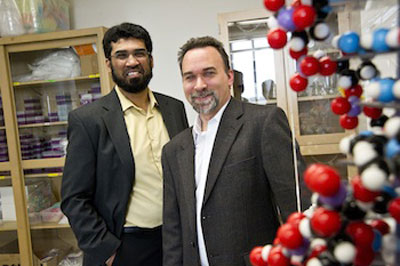| Mar 11, 2011 |
Researchers use nanotechnology in gene detection to show disposition to certain cancers
|
|
(Nanowerk News) Researchers at The University of Texas at Arlington are perfecting a system to detect a gene mutation implicated in 90 percent of pancreatic cancers and often in lung cancer by running tiny amounts of blood over nanomaterials.
|
|
Their work will help physicians give more information to patients who are predisposed to certain maladies and prescribe therapy and healthy behaviors that may delay or eliminate the risk of certain diseases.
|
|
The research is "a major breakthrough that can benefit millions of people who acquire disease like cancer from their inherited or malfunctioning genes," according to professors Samir Iqbal and Shawn Christensen, who are leading the effort.
|
 |
| Samir Iqbal (left) electrical engineering assistant professor, and Shawn Christensen, assistant professor in biology, work on a collaborative project that more accurately detects certain types of cancer.
|
|
Iqbal and Christensen said their process improves speed, electrical detection, sensitivity and portability.
|
|
Iqbal, an electrical engineering assistant professor, and Christensen, an assistant professor and genetic biologist, have published a paper in the journal Applied Physics Letters that gives proof of concept of their process. The work was chosen as the cover story for the journal in 2009.
|
|
The team also has presented their work at the National Institutes of Health campus in a joint workshop of the NIH and the Institute of Electrical and Electronics Engineers. The work received accolades and the best paper award in 2009.
|
|
"What it means potentially is that anything that is known to be a genetic marker for certain diseases, can be detected within a few minutes," Iqbal said. "We use electrical detection to fish for certain genes and detect these from very, very small samples."
|
|
Christensen said that there are many different versions, or alleles, of a given gene within a population. Each individual may have a slightly different variation of a gene due to mutation and genetic recombination.
|
|
Some mutations can predispose an individual to a given disease. Others may lead to protection from the same or different disease. For example, an allele of a trim5? gene was selected for by natural selection because it protected our ancestors against an ancient retrovirus, but that same allele contributes to our vulnerability to HIV infection today, Christensen said.
|
|
"Our work could be used to detect any genetic marker," Christensen said. "If a disease has a known genetic component to it, we can tell you whether you have the gene that might lead to the disease."
|
|
Their screening process uses about a quarter of a milliliter or blood, or a little more than the amount of blood needed from a diabetic to test for blood glucose.
|
|
Other processes exist to accomplish similar results, but they require detection of florescence dies or radioactivity, more labor or bulky, expensive machinery, the researchers said.
|
|
"We could incorporate the electrical detection process we used into a small hand-held device that could used outside the laboratory," Iqbal said.
|
|
Iqbal is using part of a five-year, $400,000 National Science Foundation Early CAREER grant to support the gene mutation research. He is in the third year of that grant. CAREER grants support the early career development activities of faculty who exemplify outstanding research, excellent teaching and innovative integration of education and research.
|
|
Christensen is supported by a three-year $677,958 grant from the Molecular and Cellular Biosciences section of the National Science Foundation to study non-LTR retrotransposons, a class of selfish mobile genetic elements whose activity has generated 34 percent of the human genome.
|
|
The team includes a number of undergraduate and graduate students from Texas, students who ultimately will make strong contributions to state's high-tech workforce, the professors said.
|

